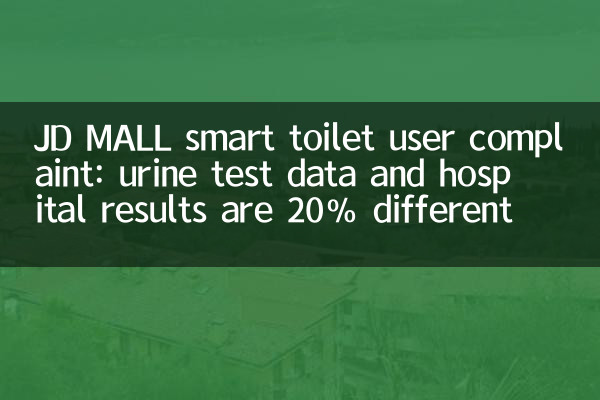JD MALL smart toilet user complaint: urine test data and hospital results are 20% different
Recently, a smart toilet priced at JD MALL cost up to 15,000 yuan has caused user complaints due to the accuracy of urine test data. Many consumers reported that the test results of this product are significantly different from the hospital's professional reports, and some indicators are even deviated by more than 20%, which has caused doubts about the reliability of smart health devices.
Event background

This smart toilet mainly features "contactless health monitoring" function, claiming that it can detect 14 health indicators through urine analysis, including urine protein, urine sugar, uric acid, etc. The product page displays slogans such as "medical-grade testing accuracy" and "grand-level hospital homologous technology". However, since its listing in September, 23 related complaints have been registered on the Black Cat Complaints Platform.
| Complaint time | area | Testing items | Deviation magnitude |
|---|---|---|---|
| 2023-10-05 | Beijing | Urine protein | 18% |
| 2023-10-08 | Shanghai | Urine sugar | twenty two% |
| 2023-10-11 | Guangzhou | Uric acid | 15% |
Typical cases comparison
Comparative data provided by Shenzhen user Mr. Wang showed that on October 9, the urine protein value of smart toilets was 0.25g/L, while the inspection report of Grade A hospitals showed that it was 0.31g/L, with a difference of 19.4%. Similar situations are more obvious in urine sugar testing in diabetic patients.
| Testing items | Smart toilet data | Hospital data | Difference rate |
|---|---|---|---|
| Urine sugar (mmol/L) | 3.8 | 4.7 | 23.4% |
| Urine-Bloodys (μmol/L) | 8.2 | 9.1 | 10.9% |
Technical principles controversy
Medical equipment experts point out that civil-grade detection equipment is limited by sensor accuracy and environmental interference, and usually allows an error range of 15%-20%. However, the product did not clearly mark error standards, which were suspected of violating the "Medical Device Supervision and Administration Regulations". JD MALL customer service responded that "the data is for reference only and cannot replace professional medical testing."
Comparison of industry status
The error rate of current mainstream health monitoring equipment is as follows:
| Equipment Type | Average error rate | Medical Certification |
|---|---|---|
| Smart toilet (disputed product) | 18.7% | none |
| Medical urine analyzer | ≤5% | Class II medical devices |
| Blood glucose meter | ≤15% | Class I medical devices |
Consumer rights protection
Beijing Consumer Association reminds: When purchasing smart devices with medical testing functions, you must confirm whether they have passed the certification of the Drug Administration. For products that claim to be "medical grade" but have not obtained relevant qualifications, consumers may claim triple compensation in accordance with Article 55 of the Consumer Rights Protection Law. At present, 7 consumers have initiated collective rights protection.
Manufacturer's response
Manufacturer "Zhijie Technology" issued a statement saying that it has initiated a product recall inspection procedure and will provide free third-party inspection services to users with doubts. JD MALL simultaneously removed relevant promotional slogans, adding a significant prompt to "test data is not used as the basis for diagnosis and treatment" to the product page.
Expert advice
Li Ming, deputy director of the Medical Device Research Institute of Tsinghua University, suggested:
1. Household health monitoring equipment should clearly mark the error range
2. Key indicators need to be automatically calibrated every hour
3. If the test results are abnormal, you should be prompted to seek medical treatment.
4. Functions involving chronic disease monitoring should apply for medical certification
As of press time, the incident has caused 230 million views on Weibo, and related topics have reached the 7th place in the hot search list. The State Administration for Market Regulation stated that it has paid attention to this matter and will formulate stricter standards and specifications for emerging smart health devices.

check the details

check the details